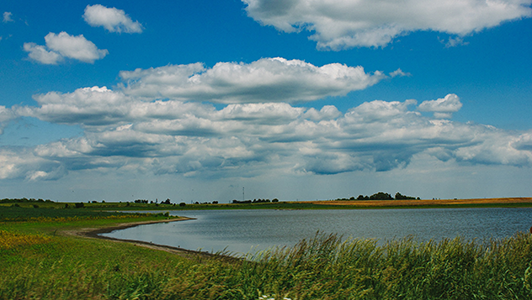
Landowners can slow the increase of algae by allowing grasses and forbs to grow around a pond.
K-State expert urges landowners to watch for algae in ponds, protect aquatic life
Clean water also benefits livestock, says K-State's Gerken
May 4, 2023
K-State Research and Extension news service
MANHATTAN, Kan. – Kansas State University fisheries and aquatics specialist Joe Gerken said dead fish in a pond could be a result of algae that robs the pond of oxygen.
Gerken said filamentous algae –commonly called pond moss – can form when a pond fills with sediment and sunlight hits the bottom of the pond, increasing plant growth. When pond moss dies, bacteria will eat it up, potentially using up oxygen needed by other aquatic life and creating an unlivable environment for fish, he said.
“We want to make sure we can get it under control and get it out of the pond as quickly as we can to keep that pond healthy,” Gerken said.
Nutrient run-off from lawn fertilizer or nearby agricultural fields can also contribute to algae growth, according to Gerken.
He added that one of the easiest things landowners can do to slow the increase of algae in the pond is to allow grasses and forbs to grow around the pond.
“Those plants are going to take up a lot of the nutrients that would otherwise be washing in,” he said. “So let them grow up.”
Mowing strips in the grass to access the pond is all right, but “allowing it to grow where possible is best.”
When prevention fails, Gerken shared tips on how to treat pond moss:
- Mechanical control. “You want to make sure when algae is removed from the water, you remove it from the watershed,” Gerken said. “If not, the nutrients will likely get back into the water.”
- Biological control. “In Kansas, the most common fish that we see is the white amur or the grass carp,” Gerken said. Grass carp are picky eaters and can cause additional problems in ponds if they aren’t managed correctly.
- Chemical control. “There are a lot of times when we need chemicals, but some of the other options are better,” Gerken said. If using chemicals, Gerken said it is important to use aquatic herbicide and treat one-quarter of the pond at a time. He added that chemicals “are kind of a last-ditch effort.”
Interested persons can also contact your local K-State Research and Extension office.

